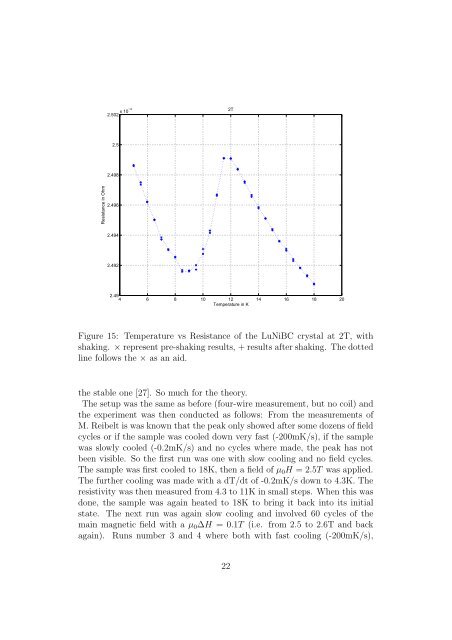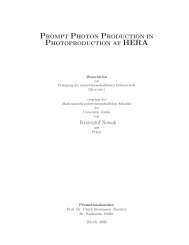Master Thesis Effect of vortex shaking on the ... - Physik-Institut
Master Thesis Effect of vortex shaking on the ... - Physik-Institut
Master Thesis Effect of vortex shaking on the ... - Physik-Institut
You also want an ePaper? Increase the reach of your titles
YUMPU automatically turns print PDFs into web optimized ePapers that Google loves.
2.502 x 10−4 2T<br />
2.5<br />
2.498<br />
Resistance in Ohm<br />
2.496<br />
2.494<br />
2.492<br />
2.49<br />
4 6 8 10 12 14 16 18 20<br />
Temperature in K<br />
Figure 15: Temperature vs Resistance <str<strong>on</strong>g>of</str<strong>on</strong>g> <strong>the</strong> LuNiBC crystal at 2T, with<br />
<str<strong>on</strong>g>shaking</str<strong>on</strong>g>. × represent pre-<str<strong>on</strong>g>shaking</str<strong>on</strong>g> results, + results after <str<strong>on</strong>g>shaking</str<strong>on</strong>g>. The dotted<br />
line follows <strong>the</strong> × as an aid.<br />
<strong>the</strong> stable <strong>on</strong>e [27]. So much for <strong>the</strong> <strong>the</strong>ory.<br />
The setup was <strong>the</strong> same as before (four-wire measurement, but no coil) and<br />
<strong>the</strong> experiment was <strong>the</strong>n c<strong>on</strong>ducted as follows: From <strong>the</strong> measurements <str<strong>on</strong>g>of</str<strong>on</strong>g><br />
M. Reibelt is was known that <strong>the</strong> peak <strong>on</strong>ly showed after some dozens <str<strong>on</strong>g>of</str<strong>on</strong>g> field<br />
cycles or if <strong>the</strong> sample was cooled down very fast (-200mK/s), if <strong>the</strong> sample<br />
was slowly cooled (-0.2mK/s) and no cycles where made, <strong>the</strong> peak has not<br />
been visible. So <strong>the</strong> first run was <strong>on</strong>e with slow cooling and no field cycles.<br />
The sample was first cooled to 18K, <strong>the</strong>n a field <str<strong>on</strong>g>of</str<strong>on</strong>g> µ 0 H = 2.5T was applied.<br />
The fur<strong>the</strong>r cooling was made with a dT/dt <str<strong>on</strong>g>of</str<strong>on</strong>g> -0.2mK/s down to 4.3K. The<br />
resistivity was <strong>the</strong>n measured from 4.3 to 11K in small steps. When this was<br />
d<strong>on</strong>e, <strong>the</strong> sample was again heated to 18K to bring it back into its initial<br />
state. The next run was again slow cooling and involved 60 cycles <str<strong>on</strong>g>of</str<strong>on</strong>g> <strong>the</strong><br />
main magnetic field with a µ 0 ∆H = 0.1T (i.e. from 2.5 to 2.6T and back<br />
again). Runs number 3 and 4 where both with fast cooling (-200mK/s),<br />
22
















